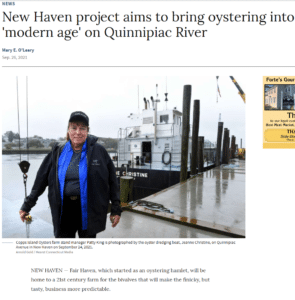Our project for the Quinnipiac River Oyster Farm has been approved by New Haven’s City Plan Department.
Check out the article here.
New Haven project aims to bring oystering into ‘modern age’ on Quinnipiac River

Copps Island Oysters farm stand manager Patty King is photographed by the oyster dredging boat, Jeanne Christine, on Quinnipiac Avenue in New Haven on September 24, 2021.Arnold Gold / Hearst Connecticut Media
NEW HAVEN — Fair Haven, which started as an oystering hamlet, will be home to a 21st century farm for the bivalves that will make the finicky, but tasty, business more predictable.
Copps Island Oysters has gotten approval for a permit, variance and site plan to upgrade its longtime operation on the Quinnipiac River, a process that took years of planning and discussions with neighbors and the Historic District Commission, all of which was slowed further by the pandemic.
The project, based on other successful models around the country, will recreate the growing conditions for the broadstock in a hatchery to allow them to get big enough to be placed in beds for harvesting later.

Two historic buildings at Copps Island Oysters that will be moved during the expansion of the business on Quinnipiac Avenue in New Haven on September 24, 2021.Arnold Gold / Hearst Connecticut Media
The approvals were smooth going, eliciting praise at a City Plan Commission meeting, a gathering not often given over to such expressions.
Edward Mattison, another commissioner, said it was “fascinating to see what is needed in order to help nature.” He suggested they open the site to public tours.
He complimented the owners for being sensitive to the concerns of neighbors and the history of the site.
Fair Haven gained prominence in the mid-19th century as a major oyster port, according to the Quinnipiac River Historic District’s application for district recognition.
Norman Bloom and his son, James Bloom, who own the properties, are part of an oystering family that goes back to the 1940s.

Paolo Campos of Patriquin Architects, which designed the improvements, said Copps Island Oysters manages farm operations up and down Long Island Sound, from Norwalk to Mystic.
Anyone traveling down Quinnipiac Avenue to the intersection with Grand Avenue will be familiar with the large shell pile on the property, which is seasonal.
It goes up in January and is taken down in July when it is returned to the oyster bed sites at spawning time. This is essential to the operation and will reappear again in four months.

The company, after complaints by neighbors about an odor coming from the shells, now uses a cleaning formula that appears to have corrected the problem.
The development upgrade includes improvements throughout the site from the entrance to parking and bulkhead repairs, but the main changes cover construction of an oyster house, the hatchery and relocation of two historic buildings.
The hatchery, which will be adjacent to the river, will have three floors.
The first two have large spawning and culture tanks where the babies, or broadstock, are formed and fed by the river water and algae that is grown in a greenhouse on the third floor.
That top floor will have a large, glass roof with solar collectors that take in sunlight focused on the growth tanks.

Once the larvae are big enough they are moved to setting tanks where they attach to shells to become spat. The spat are assessed as to size and strength before they are shipped to prepared oyster beds throughout Long Island Sound.
“The key thing is, we are mimicking nature here in this building. Their whole life cycle is based on filter feeding,” which is why they need the river water, Campos said. In nature, they spawn in brackish or estuary water.
To mitigate against the pump system that moves the water from clogging, Campos said there will be built-in redundancy with at least two of all the pipes and pumps.
“If you get a blockage, which could kill the oysters, you can bypass to another system,” he said.
The last strategy is to have the hatchery as close to the river as possible, which works to keep it running smoothly.
The new oyster house will be two stories with the lower level designed to be wet flood protected, which means floodwater can flow through it.
All the utilities will be 14 feet above base flood level; the upper level will be office and meeting space.

The two small historic buildings, which are contributing structures to the historic district, will be moved from the floodplain and placed elsewhere on the property.
Campos said the new process will be maintenance intensive, but the outcome should be more certainty of having a successful product.
King said the company has run small test programs the last two summers and found that the larvae have done well with water from the Quinnipiac.
Donna Curran, who lives next door, said her only concern is the timeline for the project, which she hopes is not long with unfinished portions lingering.
Chris Ozyck, a neighbor from across the street, said he is excited by the plans on many levels.
He said it is a business that defines the neighborhood with Fair Haven tied so closely to oystering.
Ozyck said he also lives in an oyster baron’s former home and as an environmentalist appreciates the fact that oysters, along with catfish, are the only aquatic creatures that clean the water.
He said the project opens opportunities for educational discussions both historic and biological, while the new hatchery will animate the waterfront.
There are a few more steps for the project as the Historic District approval was conditional, while the state Department of Energy and Environmental Protection needs to weigh in on bulkhead repairs.

